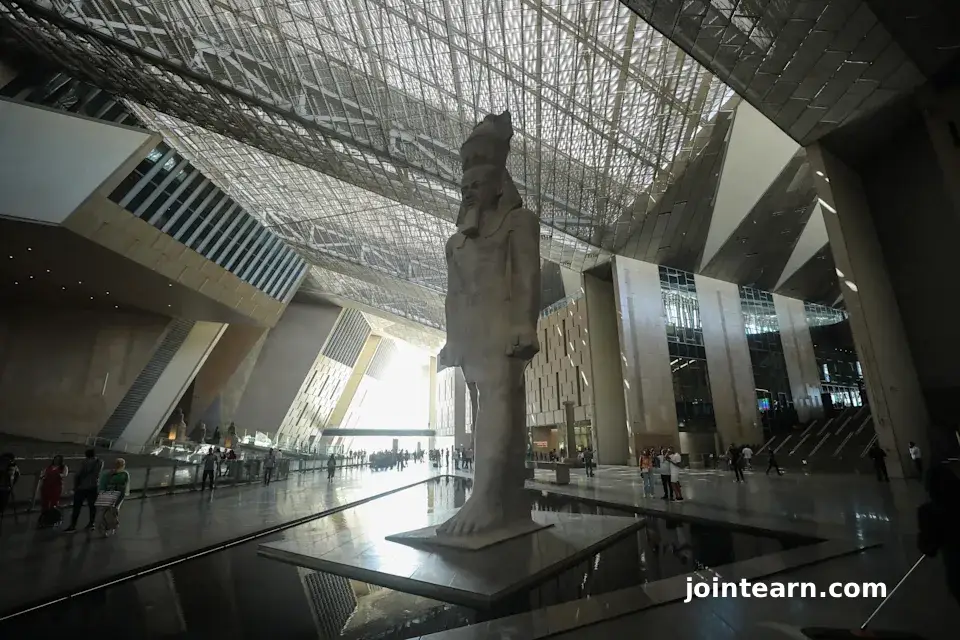
Egypt Unveils the Grand Egyptian Museum — The World’s Largest Tribute to Ancient Civilization
CAIRO — After decades of planning, delays, and international anticipation, Egypt is finally ready to open the Grand Egyptian Museum (GEM) — a $1 billion architectural and cultural landmark located just a mile from the Pyramids of Giza. The official opening ceremony, scheduled for Saturday, will host dozens of world leaders, dignitaries, and scholars, marking a historic moment in the preservation of Egypt’s rich heritage.
Spanning over 5 million square feet, the Grand Egyptian Museum is the largest archaeological museum in the world dedicated to a single civilization: ancient Egypt. The vast complex houses more than 100,000 artifacts covering 7,000 years of history — from prehistoric times through the Greek and Roman periods.
From Vision to Reality: A Project 30 Years in the Making
The concept for a museum of this scale began over 30 years ago. The Egyptian government first designated a 117-acre site in 1992, envisioning a structure that would reflect Egypt’s grandeur. An international architectural competition in 2002 attracted 2,227 participants from 103 countries. The winning design came from Heneghan Peng Architects, an Irish firm known for its innovative, minimalist approach.
Originally projected to open in 2010, the museum faced multiple setbacks — from the global financial crisis and political upheavals to the COVID-19 pandemic. Despite these challenges, Egypt’s perseverance and international partnerships transformed the project into a $1 billion masterpiece that symbolizes resilience and cultural pride.
A Modern Architectural Wonder Rooted in Ancient Inspiration
The museum’s triangular design mirrors the alignment of the three Great Pyramids. Its walls and sloping ceilings extend toward the pyramid peaks but never surpass their height — a subtle homage to the ancient builders’ legacy. Engineers excavated over 79 million cubic feet of sand to achieve this precise alignment, reshaping the landscape to integrate the museum seamlessly with its surroundings.
Inside, visitors are greeted by the Grand Staircase, a breathtaking ascent flanked by colossal statues that guide guests through Egypt’s dynastic eras. The staircase leads to 12 massive exhibition halls covering nearly 200,000 square feet of gallery space.
A Collection Beyond Imagination: 100,000 Artifacts on Display
The Grand Egyptian Museum’s collection is unparalleled. It houses around 100,000 historical treasures, nearly double the initial estimate. Among the most iconic displays is the entire collection of King Tutankhamun, presented together for the first time since its discovery by Howard Carter in 1922. More than 5,000 artifacts — including the golden mask, jewelry, chariots, and furniture — are displayed in a dedicated six-times-larger gallery than the previous Cairo Museum exhibit.
Also featured are the boats of King Khufu, built over 4,500 years ago and believed to accompany the pharaoh into the afterlife. Painstakingly restored and relocated from the Great Pyramid site, the boats stand as marvels of ancient Egyptian engineering.
The Iconic Ramses II Statue and the Hanging Obelisk
Visitors will encounter the 83-ton statue of Pharaoh Ramses II, majestically positioned in the museum’s main atrium. The statue was transported in 2006 from downtown Cairo to Giza, an event broadcast live as millions watched its careful journey.
Outside, the Hanging Obelisk — the only one of its kind in the world — greets guests at the entrance. Suspended on a glass platform, the 3,500-year-old monument allows visitors to view its inscriptions from below, blending ancient craftsmanship with modern innovation.
A Beacon for Global Tourism and Cultural Exchange
The Grand Egyptian Museum is expected to become one of the top tourist attractions in Egypt, drawing an estimated five million visitors annually. Its opening comes as Egypt intensifies efforts to revive tourism — a cornerstone of its economy.
Beyond its monumental exhibits, the museum includes research facilities, conservation labs, and education centers, ensuring it serves both as a tourist destination and a scholarly hub for Egyptologists and historians.
The Grand Opening Ceremony: A Global Event
According to government sources, over 40 heads of state, including royalty and global cultural leaders, are expected to attend the official inauguration. The ceremony is anticipated to showcase Egypt’s historical continuity and its role as a global center of civilization.
“The Grand Egyptian Museum stands as a bridge between the past and the future,” said a government spokesperson. “It’s not just a museum — it’s a message to the world that Egypt remains a cradle of culture and human achievement.”
Egypt’s Cultural Renaissance
The opening of the GEM aligns with Egypt’s broader Vision 2030, aimed at revitalizing national identity and boosting international cultural tourism. With panoramic views of the pyramids, cutting-edge design, and an unmatched collection, the Grand Egyptian Museum is poised to redefine global perceptions of heritage, art, and architecture.
Visitors to the GEM won’t just see history — they’ll walk through it.


Leave a Reply